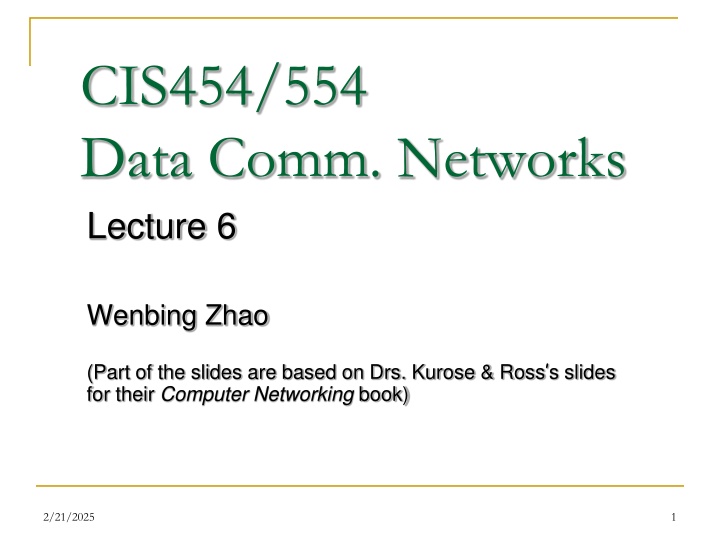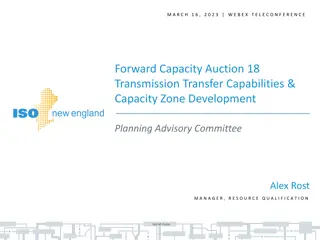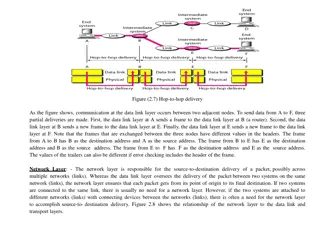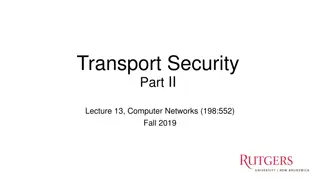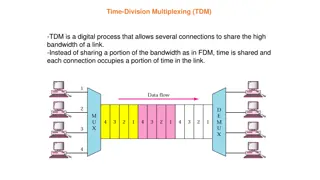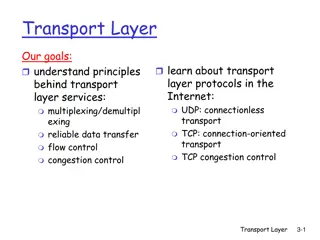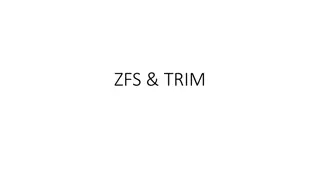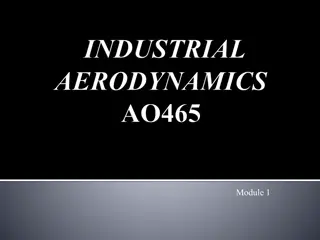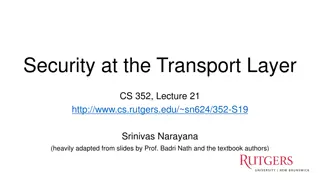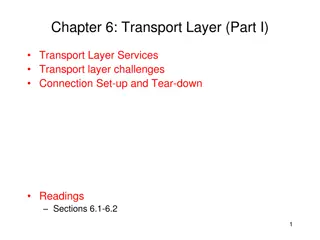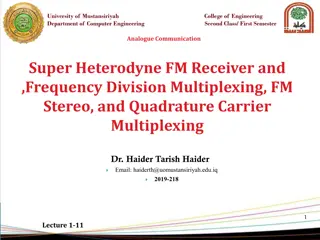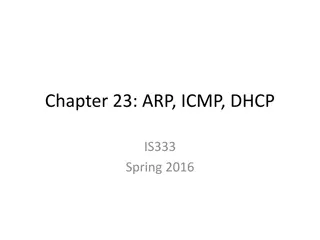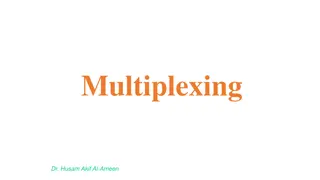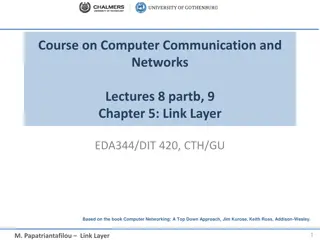Transport Layer Essentials: Multiplexing, Demultiplexing, Reliable Transfer
Dive into the fundamental concepts of the transport layer, including multiplexing, demultiplexing, and reliable data transfer. Explore the key protocols UDP and TCP, understanding their roles in connectionless and connection-oriented transport, as well as congestion and flow control mechanisms. Uncover the intricacies of internet transport-layer protocols for reliable and unordered delivery, with emphasis on TCP's in-order delivery and congestion control.
Download Presentation

Please find below an Image/Link to download the presentation.
The content on the website is provided AS IS for your information and personal use only. It may not be sold, licensed, or shared on other websites without obtaining consent from the author.If you encounter any issues during the download, it is possible that the publisher has removed the file from their server.
You are allowed to download the files provided on this website for personal or commercial use, subject to the condition that they are used lawfully. All files are the property of their respective owners.
The content on the website is provided AS IS for your information and personal use only. It may not be sold, licensed, or shared on other websites without obtaining consent from the author.
E N D
Presentation Transcript
CIS454/554 Data Comm. Networks Lecture 6 Wenbing Zhao (Part of the slides are based on Drs. Kurose & Ross s slides for their Computer Networking book) 2/21/2025 1
Outline Quiz#1 result Introduction to transport layer Multiplexing/demultiplexing Reliable data transfer 2/21/2025 2
CIS454 Quiz#1 Result Max: , Min: , Mean: Q1: , Q2: , Q3: , Q4: 2/21/2025 2/21/2025 Wenbing Zhao 3
Transport Layer Our goals: Understand principles behind transport layer services: multiplexing/ demultiplexing reliable data transfer flow control congestion control Learn about transport layer protocols in the Internet: UDP: connectionless transport TCP: connection-oriented transport TCP congestion control 2/21/2025 4
Internet Transport-Layer Protocols Reliable, in-order delivery (TCP) congestion control flow control connection setup Unreliable, unordered delivery: UDP no-frills extension of best- effort IP Services not available: delay guarantees bandwidth guarantees application transport network data link physical network data link physical network data link physical network data link physical network data link physical network data link physical application transport network data link physical 2/21/2025 5
Multiplexing/Demultiplexing Multiplexing at send host: Demultiplexing at rcv host: gathering data from multiple sockets, enveloping data with header (later used for demultiplexing) delivering received segments to correct socket = socket = process P4 application P1 P1 P2 P3 application application transport transport transport network network network link link link physical physical physical host 3 host 2 host 1 2/21/2025 6
How Demultiplexing Works Host receives IP datagrams Each datagram has source IP address, destination IP address Each datagram carries 1 transport-layer segment Each segment has source, destination port number Host uses IP addresses & port numbers to direct segment to appropriate socket 32 bits source port # dest port # other header fields application data (message) TCP/UDP segment format 2/21/2025 7
Connectionless Demultiplexing When host receives UDP segment: checks destination port number in segment directs UDP segment to socket with that port number IP datagrams with different source IP addresses and/or source port numbers directed to same socket Create sockets with port numbers: DatagramSocket mySocket1 = new DatagramSocket(12534); DatagramSocket mySocket2 = new DatagramSocket(12535); UDP socket identified by two- tuple: (dest IP address, dest port number) 2/21/2025 8
Connectionless Demux DatagramSocket serverSocket = new DatagramSocket(6428); P1 P1 P2 P3 SP: 6428 DP: 9157 SP: 6428 DP: 5775 SP: 9157 DP: 6428 SP: 5775 DP: 6428 client IP: A Client IP:B server IP: C SP provides return address 2/21/2025 9
Connection-Oriented Demux TCP socket identified by 4- tuple: source IP address source port number dest IP address dest port number recv host uses all four values to direct segment to appropriate socket Server host may support many simultaneous TCP sockets: each socket identified by its own 4-tuple Web servers have different sockets for each connecting client non-persistent HTTP will have different socket for each request 2/21/2025 10
Connection-Oriented Demux P1 P2 P6 P1 P4 P5 P3 SP: 5775 DP: 80 S-IP: B D-IP:C SP: 9157 DP: 80 S-IP: A D-IP:C SP: 9157 DP: 80 S-IP: B client IP: A Client IP:B server IP: C D-IP:C 2/21/2025 11
Connection-oriented demux: Multi-Threaded Web Server P1 P2 P1 P4 P3 SP: 5775 DP: 80 S-IP: B D-IP:C SP: 9157 DP: 80 S-IP: A D-IP:C SP: 9157 DP: 80 S-IP: B client IP: A Client IP:B server IP: C D-IP:C 2/21/2025 12
Principles of Reliable Data Transfer Important in app., Transport, link layers Top-10 list of important networking topics! Characteristics of unreliable channel will determine complexity of reliable data transfer protocol (rdt) 2/21/2025 13
Reliable Data Transfer: Getting Started rdt_send():called from above, (e.g., by app.). Passed data to deliver to receiver upper layer deliver_data():called by rdt to deliver data to upper send side receive side udt_send():called by rdt, to transfer packet over unreliable channel to receiver rdt_rcv():called when packet arrives on rcv-side of channel 2/21/2025 14
Reliable Data Transfer: Getting Started We ll: Incrementally develop sender, receiver sides of reliable data transfer protocol (rdt) Consider only unidirectional data transfer but control info will flow on both directions! Use finite state machines (FSM) to specify sender, receiver event causing state transition actions taken on state transition state: when in this state next state uniquely determined by next event state 1 state 2 event actions 2/21/2025 15
rdt1.0: reliable transfer over a reliable channel Underlying channel perfectly reliable No bit errors No loss of packets Separate fsms for sender, receiver: Sender sends data into underlying channel Receiver read data from underlying channel rdt_rcv(packet) rdt_send(data) Wait for call from below Wait for call from above extract (packet,data) deliver_data(data) packet = make_pkt(data) udt_send(packet) sender receiver 2/21/2025 16
rdt2.0: channel with bit errors Underlying channel may flip bits in packet Checksum to detect bit errors The question: how to recover from errors: Acknowledgements (acks): receiver explicitly tells sender that pkt received OK Negative acknowledgements (naks): receiver explicitly tells sender that pkt had errors Sender retransmits pkt on receipt of NAK New mechanisms in rdt2.0 (beyond rdt1.0): Error detection Receiver feedback: control msgs (ACK,NAK) rcvr->sender 2/21/2025 17
rdt2.0: FSM specification rdt_send(data) receiver snkpkt = make_pkt(data, checksum) udt_send(sndpkt) rdt_rcv(rcvpkt) && isNAK(rcvpkt) Wait for call from above Wait for ACK or NAK rdt_rcv(rcvpkt) && corrupt(rcvpkt) udt_send(sndpkt) udt_send(NAK) rdt_rcv(rcvpkt) && isACK(rcvpkt) Wait for call from below sender rdt_rcv(rcvpkt) && notcorrupt(rcvpkt) extract(rcvpkt,data) deliver_data(data) udt_send(ACK) 2/21/2025 18
rdt2.0: operation with no errors rdt_send(data) snkpkt = make_pkt(data, checksum) udt_send(sndpkt) rdt_rcv(rcvpkt) && isNAK(rcvpkt) Wait for call from above Wait for ACK or NAK rdt_rcv(rcvpkt) && corrupt(rcvpkt) udt_send(sndpkt) udt_send(NAK) rdt_rcv(rcvpkt) && isACK(rcvpkt) Wait for call from below rdt_rcv(rcvpkt) && notcorrupt(rcvpkt) extract(rcvpkt,data) deliver_data(data) udt_send(ACK) 2/21/2025 19
rdt2.0: error scenario rdt_send(data) snkpkt = make_pkt(data, checksum) udt_send(sndpkt) rdt_rcv(rcvpkt) && isNAK(rcvpkt) Wait for call from above Wait for ACK or NAK rdt_rcv(rcvpkt) && corrupt(rcvpkt) udt_send(sndpkt) udt_send(NAK) rdt_rcv(rcvpkt) && isACK(rcvpkt) Wait for call from below rdt_rcv(rcvpkt) && notcorrupt(rcvpkt) extract(rcvpkt,data) deliver_data(data) udt_send(ACK) 2/21/2025 20
rdt2.0 has a fatal flaw! What happens if ACK/NAK corrupted? sender doesn t know what happened at receiver! can t just retransmit: possible duplicate Handling duplicates: sender retransmits current pkt if ACK/NAK garbled sender adds sequence number to each pkt receiver discards (doesn t deliver up) duplicate pkt stop and wait Sender sends one packet, then waits for receiver response 2/21/2025 21
rdt2.1: sender handles garbled ACK/NAKs rdt_send(data) sndpkt = make_pkt(0, data, checksum) udt_send(sndpkt) rdt_rcv(rcvpkt) && ( corrupt(rcvpkt) || isNAK(rcvpkt) ) Wait for ACK or NAK 0 Wait for call 0 from above udt_send(sndpkt) rdt_rcv(rcvpkt) && notcorrupt(rcvpkt) && isACK(rcvpkt) rdt_rcv(rcvpkt) && notcorrupt(rcvpkt) && isACK(rcvpkt) Wait for ACK or NAK 1 Wait for call 1 from above rdt_rcv(rcvpkt) && ( corrupt(rcvpkt) || isNAK(rcvpkt) ) rdt_send(data) sndpkt = make_pkt(1, data, checksum) udt_send(sndpkt) udt_send(sndpkt) 2/21/2025 22
rdt2.1: receiver handles garbled packets rdt_rcv(rcvpkt) && notcorrupt(rcvpkt) && has_seq0(rcvpkt) extract(rcvpkt,data) deliver_data(data) sndpkt = make_pkt(ACK, chksum) udt_send(sndpkt) rdt_rcv(rcvpkt) && (corrupt(rcvpkt) rdt_rcv(rcvpkt) && (corrupt(rcvpkt) sndpkt = make_pkt(NAK, chksum) udt_send(sndpkt) sndpkt = make_pkt(NAK, chksum) udt_send(sndpkt) Wait for 0 from below Wait for 1 from below rdt_rcv(rcvpkt) && not corrupt(rcvpkt) && has_seq1(rcvpkt) rdt_rcv(rcvpkt) && not corrupt(rcvpkt) && has_seq0(rcvpkt) sndpkt = make_pkt(ACK, chksum) udt_send(sndpkt) sndpkt = make_pkt(ACK, chksum) udt_send(sndpkt) rdt_rcv(rcvpkt) && notcorrupt(rcvpkt) && has_seq1(rcvpkt) extract(rcvpkt,data) deliver_data(data) sndpkt = make_pkt(ACK, chksum) udt_send(sndpkt) 2/21/2025 23
rdt2.1: discussion Sender: seq # added to pkt two seq. # s (0,1) will suffice. Why? must check if received ACK/NAK corrupted twice as many states state must remember whether current pkt has 0 or 1 seq. # Receiver: must check if received packet is duplicate state indicates whether 0 or 1 is expected pkt seq # note: receiver can not know if its last ACK/NAK received OK at sender 2/21/2025 24
rdt2.2: a NAK-free protocol Same functionality as rdt2.1, using acks only Instead of NAK, receiver sends ACK for last pkt received OK Receiver must explicitly include seq # of pkt being acked Duplicate ACK at sender results in same action as NAK: retransmit current pkt 2/21/2025 25
rdt2.2: sender, receiver fragments rdt_send(data) sndpkt = make_pkt(0, data, checksum) udt_send(sndpkt) rdt_rcv(rcvpkt) && ( corrupt(rcvpkt) || isACK(rcvpkt,1) ) Wait for ACK 0 Wait for call 0 from above udt_send(sndpkt) sender FSM fragment rdt_rcv(rcvpkt) && notcorrupt(rcvpkt) && isACK(rcvpkt,0) receiver FSM fragment rdt_rcv(rcvpkt) && notcorrupt(rcvpkt) && has_seq0(rcvpkt) extract(rcvpkt,data) deliver_data(data) sndpkt = make_pkt(ACK0, chksum) udt_send(sndpkt) rdt_rcv(rcvpkt) && (corrupt(rcvpkt) || has_seq1(rcvpkt)) Wait for 0 from below udt_send(sndpkt) 2/21/2025 26
rdt3.0: channels with errors and loss New assumption: underlying channel can also lose packets (data or acks) Checksum, seq. #, Acks, retransmissions will be of help, but not enough Approach: sender waits reasonable amount of time for ACK Retransmits if no ACK received in this time If pkt (or ACK) just delayed (not lost): Retransmission will be duplicate, but use of seq. # S already handles this Receiver must specify seq # of pkt being acked Requires countdown timer 2/21/2025 27
rdt3.0 sender rdt_send(data) rdt_rcv(rcvpkt) && ( corrupt(rcvpkt) || isACK(rcvpkt,1) ) sndpkt = make_pkt(0, data, checksum) udt_send(sndpkt) start_timer rdt_rcv(rcvpkt) Wait for ACK0 Wait for call 0 from above timeout udt_send(sndpkt) start_timer rdt_rcv(rcvpkt) && notcorrupt(rcvpkt) && isACK(rcvpkt,1) stop_timer rdt_rcv(rcvpkt) && notcorrupt(rcvpkt) && isACK(rcvpkt,0) stop_timer Wait for ACK1 Wait for call 1 from above timeout udt_send(sndpkt) start_timer rdt_rcv(rcvpkt) rdt_send(data) rdt_rcv(rcvpkt) && ( corrupt(rcvpkt) || isACK(rcvpkt,0) ) sndpkt = make_pkt(1, data, checksum) udt_send(sndpkt) start_timer 2/21/2025 28
rdt3.0 in action 2/21/2025 29
rdt3.0 in action 2/21/2025 30
Performance of rdt3.0 rdt3.0 works, but performance stinks ex: 1 Gbps link, 15 ms prop. delay, 8000 bit packet: 8000 bits L =R = = 8 microsecon ds dtrans 9 10 bps U sender: utilization fraction of time sender busy sending 1KB pkt every 30 msec -> 33kB/sec thruput over 1 Gbps link network protocol limits use of physical resources! 2/21/2025 31
rdt3.0: stop-and-wait operation sender receive r first packet bit transmitted, t = 0 last packet bit transmitted, t = L / R first packet bit arrives last packet bit arrives, send ACK RTT ACK arrives, send next packet, t = RTT + L / R 2/21/2025 32
